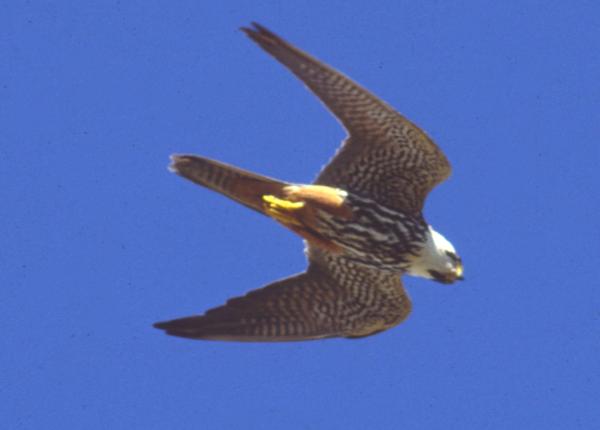Did You Know?
- There are two recognized subspecies of the Eurasian Hobby
- This falcon is very active at dawn and dusk
- Researchers documented this species following cars, hunters, or other raptors to capture small birds that are flushed
How The Peregrine Fund is Helping
Though The Peregrine Fund does not work directly with Eurasian Hobbies, our efforts in scientific research, habitat conservation, education, and community development help conserve birds of prey around the world. We also supply literature to researchers from our avian research library, which helps scientists around the world gather and share important information on raptor conservation. Additionally, our support of the Global Raptor Information Network gives raptor researchers tools to more efficiently conduct their own studies while contributing to a global program. It also provides citizen scientists a way to participate in raptor science and conservation.
Where It Lives
This falcon has a wide distribution. It is found in parts of Europe, the Middle East, Africa, and Asia. As you can image, this species is adapted to live in several different habitats including open country with patches of forest, pine forests, lowland farmland areas with patches of trees, and even urban areas with wooded parks. While in migration, it can be found in almost any climate or habitat, but is most conspicuous over grasslands and thorn scrub. On its winter range in south-central Africa, it favors moister woodland habitats.
Why it Needs our Help
This falcon is categorized as Least Concern. Scientists believe that most of the species' populations are currently stable, which is great news for this lovely raptor.
What it Eats
The Eurasian Hobby feeds on birds, such as larks, martins, swifts, finches, sparrows, and more. It also preys on flying insects such as dragonflies, moths, and locusts, as well as ants and termites. It will also take bats. Most prey items are caught on the wing.
Nests, Eggs, and Young
The Eurasian Hobby doesn't build its own nest. Instead, it most often uses the old nests built by other birds, such as crows or ravens, placed high in a tall tree, or occasionally on an electricity pylon, or cliff ledge. The female will lay 3-4 eggs and she is responsible for doing most of the incubation. While she is busy caring for her eggs, the male is busy bringing food to her and, after the nestlings hatch, to the young.
Eurasian Hobby and the World Center for Birds of Prey
The World Center for Birds of Prey offers fun ways to learn about birds of prey. From introductory videos, to live raptor presentations with a few "ambassador" falcons on hand, including an Aplomado, Peregrine and Gyrfalcon, a visit to the center has a lot to offer for those interested in learning more about raptors. In addition, interactive activities, tours, interesting videos and a children's room with activities from coloring sheets to quizzes to costumes and a touch table are available for the curious mind. Knowledgeable staff and volunteers are on hand to answer any questions you may have about the Eurasian Hobby or any other bird of prey.
References
Global Raptor Information Network. 2023. Species account: Eurasian Hobby Falco subbuteo. Downloaded from http://www.globalraptors.org on 28 Dec. 2023
Orta, J., G. M. Kirwan, and J. S. Marks (2020). Eurasian Hobby (Falco subbuteo), version 1.0. In Birds of the World (J. del Hoyo, A. Elliott, J. Sargatal, D. A. Christie, and E. de Juana, Editors). Cornell Lab of Ornithology, Ithaca, NY, USA. https://doi.org/10.2173/bow.eurhob.01









